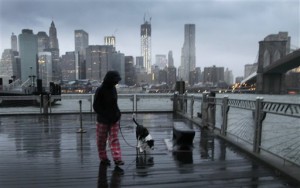US East Coast grinds to a halt as superstorm nears

Vanessa Pumo walks her dog Bella as wind and rain from Hurricane Sandy arrive, Monday in Brooklyn, New York. AP PHOTO
NEW YORK — Forecasters warned that the New York City region could face the worst of Hurricane Sandy as it bore down on the US East Coast’s largest cities Monday, forcing the shutdown of financial markets and mass transit, sending coastal residents fleeing and threatening high winds, rain and a wall of water up to 11 feet (3.35 meters) tall. It could endanger up to 50 million people for days.
Sandy strengthened before dawn and stayed on a predicted path toward New York, Washington, Baltimore and Philadelphia— putting it on a collision course with two other weather systems that would create a superstorm with the potential for havoc over 800 miles (1,280 kilometers) from the East Coast to the Great Lakes. Up to 3 feet (0.9 meters) of snow were even forecast for mountainous parts of West Virginia.
Airports closed, and authorities warned that the time for evacuation was running out or already past. Many workers planned to stay home as subways, buses and trains shut down across the region under the threat of flooding that could inundate tracks and tunnels. Utilities anticipated widespread power failures.
The center of the storm was positioned to come ashore Monday night in New Jersey, meaning the worst of the surge could be in the northern part of that state and in New York City and on Long Island. Higher tides brought by a full moon compounded the threat to the metropolitan area of about 20 million people.
“This is the worst-case scenario,” said Louis Uccellini, environmental prediction chief for the National Oceanic and Atmospheric Administration.
Article continues after this advertisementAs rain from the leading edges began to fall over the Northeast on Sunday, hundreds of thousands of people from Maryland to Connecticut were ordered to leave low-lying coastal areas, including 375,000 in lower Manhattan and other parts of New York City, 50,000 in Delaware and 30,000 in Atlantic City, New Jersey, where the city’s 12 casinos shut down for only the fourth time ever.
Article continues after this advertisementPresident Barack Obama declared emergencies in Massachusetts, Connecticut, Rhode Island, New York, New Jersey and Pennsylvania, authorizing federal relief work to begin well ahead of time. He promised the government would “respond big and respond fast” after the storm hits.
Obama cancelled a campaign appearance in Florida to stay in Washington and monitor the storm, with Election Day just a week away.
Authorities warned that New York could get hit with a surge of seawater that could swamp parts of lower Manhattan, flood subway tunnels and cripple the network of electrical and communications lines that are vital to the nation’s financial center.
Major US financial markets, including the New York Stock Exchange, Nasdaq and CME Group in Chicago, planned a rare shutdown Monday. The United Nations also shut down.
New York shut down all train, bus and subway service Sunday night. More than 5 million riders a day depend on the transit system.
“If you don’t evacuate, you are not only endangering your life, you are also endangering the lives of the first responders who are going in to rescue you,” Mayor Michael Bloomberg warned. “This is a serious and dangerous storm.”
Sandy, a Category 1 hurricane with sustained winds of 85 mph (136 kph) early Monday, was blamed for 65 deaths in the Caribbean before it began traveling northward, parallel to the Eastern Seaboard.
As of 8 a.m. Monday (1200 GMT), it was centered about 310 miles (498 kilometers) south-southeast of New York City, moving to the north at 20 mph (32.2 kph), with hurricane-force winds extending an unusual 175 miles (281 kilometers) from its center.
Sandy was expected to hook inland Monday, colliding with a wintry storm moving in from the west and cold air streaming down from the Arctic, and then cut across into Pennsylvania and travel up through New York state.
Airlines canceled nearly 7,500 flights and Amtrak began suspending train service across the Northeast.
About 90 miles (144 kilometers) off the coast of Cape Hatteras, North Carolina, 17 people abandoned a replica of the tall ship made famous in the film “Mutiny on the Bounty” after the vessel began taking on water, said Coast Guard Petty Officer 3rd Class David Weydert.
The Coast Guard was trying to determine whether to use cutters or helicopters to rescue the crew, who were in two lifeboats and were wearing survival suits and life jackets, he added.
Despite the dire warnings, some refused to budge.
Jonas Clark of Manchester Township, New Jersey — right in Sandy’s projected path — stood outside a convenience store, calmly sipping a coffee and wondering why people were working themselves “into a tizzy.”
“I’ve seen a lot of major storms in my time, and there’s nothing you can do but take reasonable precautions and ride out things the best you can,” said Clark, 73.